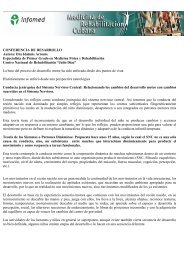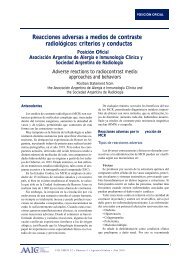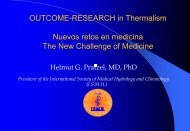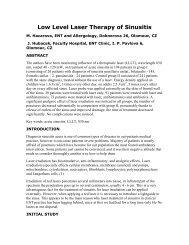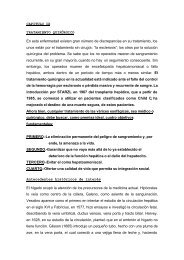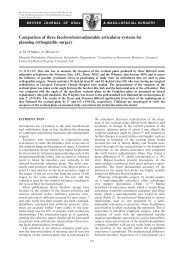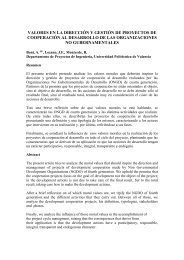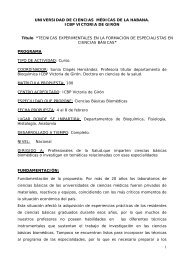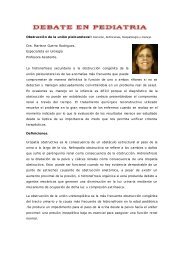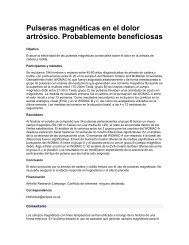pharmacology of medicinal plants and natural products
pharmacology of medicinal plants and natural products
pharmacology of medicinal plants and natural products
You also want an ePaper? Increase the reach of your titles
YUMPU automatically turns print PDFs into web optimized ePapers that Google loves.
MEDICINAL PLANTS (NATURAL PRDUCTS)<br />
S107<br />
principles <strong>and</strong> results <strong>of</strong> these studies have also been<br />
discussed. The chemistry, <strong>pharmacology</strong> <strong>and</strong> traditional<br />
<strong>medicinal</strong> uses <strong>of</strong> various Vernonia species,<br />
also called as sahadevi, (viz. Vernonia cinerea, Vernonia<br />
anthehelmintica, Vernonia amygdalina,<br />
Vernonia lasopius etc.) have been reviewed by Johri<br />
<strong>and</strong> Singh 257 . Pharmacoepidemiological survey carried<br />
out by Kar<strong>and</strong>ikar et al, 1 in adults over 60 years<br />
<strong>of</strong> age revealed that about 47% <strong>of</strong> the elderly population<br />
uses herbal drugs. The main reason for herbal<br />
drug usage is the belief that these drugs have lesser<br />
side effects.<br />
Nazarine, et al, 258 have screened two hundred <strong>and</strong><br />
sixty extracts from marine organisms collected from<br />
the Western & Eastern coasts <strong>of</strong> India, Lakshadweep<br />
<strong>and</strong> the Andaman <strong>and</strong> Nicobar Isl<strong>and</strong>s, for their effects<br />
on 3 isolated tissues <strong>of</strong> the guinea pig namely,<br />
the ileum, the uterus <strong>and</strong> the atrium with the aim <strong>of</strong><br />
detecting any anti-spasmodic, oxytocic. uterine relaxant,<br />
ionotropic <strong>and</strong> antiarrhythmic activity. Antispasmodic<br />
activity was observed in 22 extracts, ecbolic<br />
activity (spontaneous contractions in isolated<br />
uterus) in 59 samples, uterine relaxant activity in 16<br />
samples <strong>and</strong> antihistaminic <strong>and</strong> anti-5HT activity in<br />
6 samples.<br />
21.2. Toxicity studies<br />
Toxicity studies 16 revealed that LD50 <strong>of</strong> the ethanol<br />
extract <strong>of</strong> Vitex leucoxylon leaf was more than 3 g/kg<br />
whereas that <strong>of</strong> the cold aqueous infusion was 1050<br />
mg/kg. LD 50<br />
<strong>of</strong> the ethanolic extracts was found to<br />
be 1 gm/kg for Ailanthus excelsa, 350 mg/kg for<br />
Toddalia asiatica <strong>and</strong> 250 mg/kg for Araucaria bidwilli<br />
on oral administration, in rats 49 .<br />
Cerpegin, a furopyridine alkaloid isolated from the<br />
chlor<strong>of</strong>orm extract <strong>of</strong> Ceropegia juncea was found to<br />
be toxic at doses above 400 mg/kg <strong>and</strong> the mice<br />
showed excitation, irritability, convulsions <strong>and</strong> respiratory<br />
paralysis 30 .<br />
The effect <strong>of</strong> multiple doses <strong>of</strong> the petroleum ether<br />
extract <strong>of</strong> Hygrophilia spinosa on the haematological<br />
<strong>and</strong> biochemical parameters <strong>and</strong> hepatorenal functions<br />
<strong>of</strong> normal mice was evaluated 259 . The results<br />
showed that weekly moderate to high dose levels<br />
(above 40 mg/kg) <strong>and</strong> daily high dose (8 mg/kg) affected<br />
liver <strong>and</strong> kidney functions <strong>and</strong> metabolic <strong>and</strong><br />
haematological parameters. Lower doses did not alter<br />
them.<br />
Sharathch<strong>and</strong>ra <strong>and</strong> Balakrishnamurthy 260 have studied<br />
the mode <strong>of</strong> action <strong>of</strong> Cleistanthus collinus, a toxic<br />
plant that is frequently implicated in poisoning.<br />
Cleistanthus collinus causes a depletion <strong>of</strong> thiol/thiol<br />
containing enzymes in most organs which results in<br />
its toxicity. Thiol compounds may act as antidotes.<br />
Administration <strong>of</strong> the juice <strong>of</strong> Lantana camara leaves<br />
to rats resulted in a significant reduction in the total<br />
protein, globulin, absolute lymphocyte count <strong>and</strong><br />
percent lymphocyte count. Significant increase in the<br />
relative weights <strong>of</strong> adrenals was also observed. High<br />
doses (1500 mg/kg) significantly inhibited granulomatous<br />
tissue formation in rats, similar to cyclophosphamide<br />
96 .<br />
The polyherbal drug, Prostina, recommended for use<br />
in benign prostatic hypertrophy showed no toxic effects<br />
as seen on morphological, gross behaviour,<br />
body weight changes <strong>and</strong> histopathological, biochemical<br />
<strong>and</strong> haematological changes in rats upto<br />
doses <strong>of</strong> 450 mg/kg, which is 15 times higher than<br />
the recommended dose 261 .<br />
22. Elemental analysis <strong>of</strong> <strong>plants</strong> drugs/formulations<br />
Various Indian <strong>medicinal</strong> <strong>plants</strong> viz. Ocimum sanctum,<br />
Tinospora cordifolia, Azadirachta indica, Nerium<br />
<strong>and</strong>icum (Kanher) <strong>and</strong> Acorus calamus (Vacha) were<br />
analysed for the presence <strong>of</strong> minor <strong>and</strong> trace elements<br />
by instrumental neutron activation analysis<br />
(INAA). Concentrations <strong>of</strong> 13 elements were determined.<br />
Zinc, manganese, <strong>and</strong> sodium were significantly<br />
higher in Ocimum sanctum leaves while zinc<br />
was higher in Azadirachta indica leaves. The therapeutic<br />
significance <strong>of</strong> these <strong>plants</strong> in restoring ionic<br />
balance has been discussed by the authors 262 .<br />
In a similar study, specific parts <strong>of</strong> several <strong>plants</strong><br />
(fruits, leaves, stem, bark <strong>and</strong> roots) <strong>of</strong>ten used as<br />
medicines in the Indian Ayurvedic system have been<br />
analysed by Singh <strong>and</strong> Garg 263 for 20 elements (As,<br />
Ba, Br, Ca, Cl, Co, Cr, Cu, Fe, K, Mn, Mo, Na, P, Rb,<br />
Sb, Sc, Se, Sr <strong>and</strong> Zn) by employing INAA. The samples<br />
were irradiated with thermal neutrons in a nuclear<br />
reactor <strong>and</strong> the induced activity was counted<br />
using high resolution gamma ray spectrometry. Most<br />
<strong>of</strong> the <strong>medicinal</strong> herbs have been found to be rich in<br />
one or more <strong>of</strong> the elements under study. Similarly,<br />
elemental analysis <strong>of</strong> some herbal <strong>plants</strong> used in the<br />
control <strong>of</strong> diabetes has been done by the techniques




